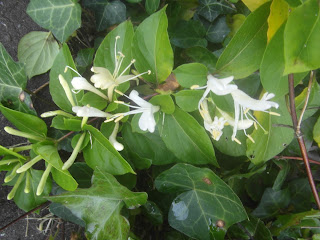This blog may help people explore some of the 'hidden' issues involved in certain media treatments of environmental and scientific issues. Using personal digital images, it's also intended to emphasise seasonal (and other) changes in natural history of the Swansea (South Wales) area. The material should help participants in field-based modules and people generally interested in the natural world. The views are wholly those of the author.
Thursday, 30 June 2016
Monday, 27 June 2016
Seeing the Changes 1089
The Hogweed (Heracleum sphondylium) was in flower in Loughor. In Bynea, Slender thistle (Carduus tenuifloris) and Common sea lavender (Limonium vulgare) were both in bloom. It has been a poor year for butterflies here, thus far, but there was quite a lot of Ringlet (Athantopus hyperanthus) activity today.
Saturday, 25 June 2016
Seeing the Changes 1088
More flowers in Bynea including Tree mallow (Lavatera arborea); Large-flowered evening primrose (Oenothera erythrosepaia); Hairy tare (Vicia hirsuta); Self-heal (Prunella vulgaris) and Hairy St John's wort (Hypericum hirsutum). In Loughor, Enchanter's nightshade (Circaea lutetiana) was conjured up and Rosebay willowherb (Epilobium augustifolium) bloomed.
Friday, 24 June 2016
Thursday, 23 June 2016
Tuesday, 21 June 2016
Monday, 20 June 2016
Saturday, 18 June 2016
NICE work?
Interesting news that NICE has approved 'in record time' the NHS adoption of a cocktail of Bristol-Myers-Squibb immunotherapy drugs for the treatment of aggressive skin cancers such as melanomas (https://www.theguardian.com/society/2016/jun/17/drug-combination-skin-cancer-melanoma-approved-nhs-nivolumab-ipilimumab). Apparently, one drug (Nivolumab) attaches itself to the T-cells (thymus cells) that are part of our body's immune recognition system, preventing the cancer cells from being taken to be identical to normal cells (the immune system destroys protein identified as 'foreign'). The second drug (Ipilimumab) encourages the multiplication of T-cells that destroy the cancer. Costs of the drugs were agreed to enable NICE to see an effect well below the NICE cost-effectiveness upper limit of £30k per year of quality life gained. A very timely development!
Wednesday, 15 June 2016
Tuesday, 14 June 2016
Friday, 10 June 2016
Stemming the Losses
Interesting news from Canada about a dangerous but, sometimes highly successful, treatment for people with Multiple Sclerosis or MS (www.theguardian.com/2016/jun/09/stem-cell-therapy-gives-hope-to-ms-patients). MS is a condition, where the body attacks its own nervous system, producing lesions in the myelin sheaths surrounding the nerves resulting in e.g. blindness and profound mobility impairments. The technique involves taking, sorting and culturing stem cells from the patient's own blood. The patient is given given a cocktail of 3 drugs that completely wipes out their immune system (this is the dangerous bit as resistance to potentially fatal infections is negated). The immune system is then 'rebooted' (amazing how the computer now provides analogies for medical treatments) by returning the stem cells that repopulate the marrow et cetera. There are attempts to reduce the severity of the treatment but it looks promising with reports of treated patients recovering vision, being engaged again in sporting activities and driving again.
Thursday, 9 June 2016
Wednesday, 8 June 2016
Tuesday, 7 June 2016
Cut and Paste
There was an interesting BBC Panorama programme on CRISPR ('Clustered Regularly Inter-spaced Short Palindromic Repeats'- the very accessible and cheap technique for 'editing' genomes by cutting out 'offending' areas and putting other sequences in) that raised numerous questions (www.bbc.co.uk/news/health-36439260). There is no doubt that this 'democratization of gene technology' has many likely benefits including enabling scientists to eliminate genes that generate debilitating medical conditions; to generate non-rejecting organs for human implantation in pigs (they have organs of a size similar to those in ourselves); to drive parasite-carrying mosquitoes to extinction et cetera. It was interesting to note, however, that kits could apparently be purchased by anyone in the US for a few tens of dollars from a converted garage. The easy availability of the technology does, however, raise some questions. Not everyone using the CRISPR might be motivated to engage in effects beneficial to society or the planet. Objections have already been raised (on ethical and religious grounds) to the 'farming' of pigs to generate replacement human organs. It is also worrying that people might choose to eliminate species without fully considering their role in the planet's ecologies; to deliberately modify organisms to attack other peoples (in health or commercial terms) or to develop characters in 'show' animals (Crufts, here we come?). It looks as if we will just have to live with the fact that humans will be cutting and pasting genes for all sorts of reasons and it will be difficult to regulate.
Subscribe to:
Comments (Atom)
-
I n the UK and US, a pparently popular and successful vegan/vegetarian restaurants are reportedly closing or adding meat to their menus ( ...
-
Early ripening fruit may seem convenient but some folk think it confirms environmental stress. There's also a possibility th...



















































%20mating%20NWCW.jpg)

